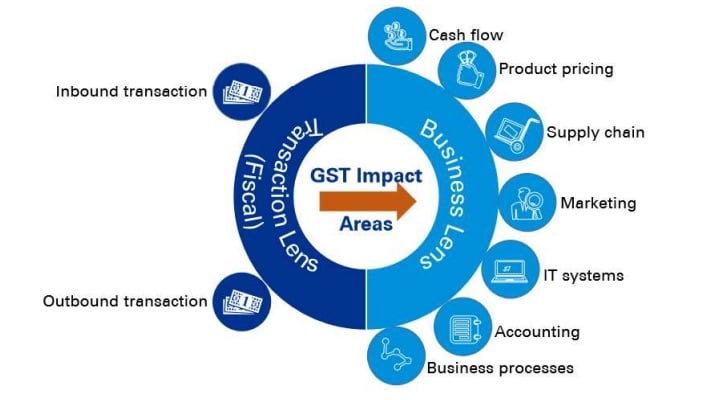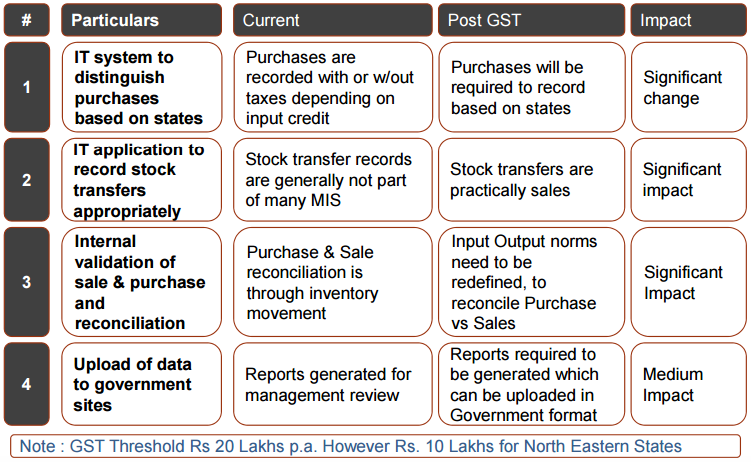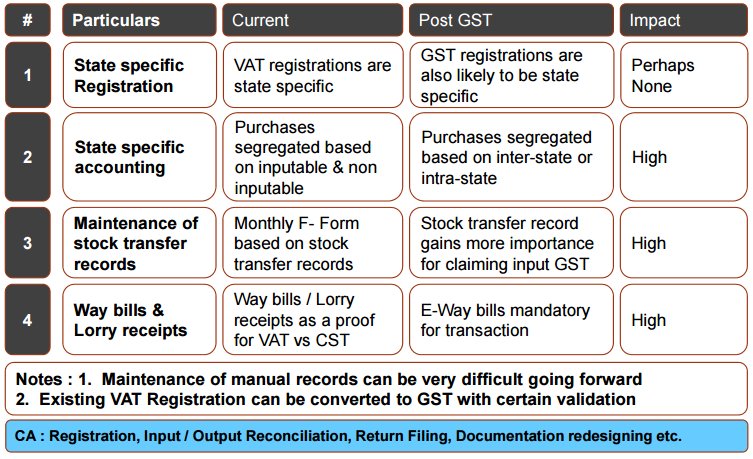Opportunities for CAs under GST Regime, Role of CA in GST 2021. As we are aware that GST is passed and will be implemented from 1st July’17, We welcome the Constitutional Amendment (GST) Bill passed by the Parliament. This is one of the biggest Tax reforms since Independence. This will bring new opportunities as well as challenges for the Chartered Accountants. The comprehensive GST regime intends to subsume most indirect taxes under a single taxation regime. In India GST will be value added tax levied across goods and services by both centre and state on a common base. This is expected to help broaden the tax base, increase tax compliance, and reduce economic distortions caused by inter-state variations in taxes.
Opportunities for CAs under GST Regime, Role of CA in GST
What an Industry is looking from CA
- GST Overview to Client in relation to Client Industry
- Assessment of Current impact of Excise Duty, VAT, Service Tax, Customs, Octroi etc. in relation to business
- Business Requirement Document – with Transaction mapping along with Process re-alignment Matrix
- Categorization of Revenue stream of the Company along with Stock Transfers
- Operational and Working Capital Impact Analysis along with Taxable Gain
- Possible modification sin IT System
- Training and Compliance Calendar
GST Overview
- GST is a Comprehensive Indirect Tax across India
- GST regime has no distinction between Goods and Service.
- The Tax will be levied at point of Supply, which will impact timing
- Dual Control established. Tax Payer andlt; 1.50 Crore Turnover be assessed by State and rest by Center.
- While Inter-State transaction attract IGST, and rest SGST + CGST. Gross Utilisation of Credits is protected.
- GST Registration may be required in each state of operation, which was the case for Goods Industry but not for Service.
- Full Chain of transaction from Manufacturer to dealer to retailer to consumer is transparent for the first time.
- Multiple GST Rates for different Category of Products and Services to protect lively hood of masses while collecting enough Tax.
- States are compensated for any loss in first 5 years. Which allows them to continue Sales tax Incentives [ PSI ] for development of Industry.
- Output Tax in most cases will be equal or higher as few Tax rates such as 0%, 5%, 12%, 28%, 28% are fixed.
GST Overview – Taxes to be subsumed

GST Overview – Key Impact areas
There is a need to look at impact areas from a twin perspective of transactions and business model

Assessment of Current Tax Losses
Excise Duty –Companies that sell Products which are Non-Excisable is not Duty able to take credit of Excise on goods procured
VAT -Companies that sell Services is not able to take credit of VAT on goods procured
Advertisement
Content in this Article
Service Tax -Companies that sell Goods is not able to take credit of Service Tax on Services procured
Octroi –Companies that sell Goods is specified cities are not able to take credit of Octroi / LBT / Entry Tax.
CST – Companies that buy goods from inter-state are unable to take credit of Central Sales Tax.
CAs can help Organisation to assess the Credits lost from above Taxes.
- As these costs are not separately booked in financial records but are added to respective expenditure, active expenditure, this requires transactional review to assess the value of credit loss.
- Generally this amount is relatively large and excites the Management of the Company and CAs can capitalize on their value addition.
Business Alignment – Procurement
Supplier Selection –Supplier selection needs to be done carefully
- Procurement of goods and service need to be balanced with Output GST in terms of IGST and SGST+CGST
- Suppliers Taxes will change and benefit needs to be negotiated.
Supplier Compliances –Companies that sell Goods is specified cities are not able to take credit of Octroi / LBT / Entry Tax.
- Supplier registration in GST is a pre-condition for Input tax
- Supplier filing of Tax returns is must
Invoicing Formats need to meet the needs of Input Credit.
CAs can help Companies by devising the proper matrix of purchase and compliances
- Purchases in the state in which there is no sale may have risks of loss input credit
- Direct Payment to suppliers rather than reimbursement to Employees may be beneficial.
- Cross Credits between SGST and CGST may not be possible.
Business Alignment – Movement of Goods
Depot / Branch Office –Need for a Depot must be re-evaluated carefully
- Every movement of Goods is an incidence of Tax. I.E., transfer of goods from Factory to it’s own Warehouse is subject to GST.
- Stock levels in Depots need to be re-examined to avoid excess stock coming back to Factory.
- Stocks expiring in Depots without sale is also subject to GST.
- Multiple Legal Entities and sale from one to another may need to re-looked.
- Valuation of Goods for the purpose of GST in case on inter-branch transfer is tricky and can exceed sale value ultimately if not planned well.
Dealers and Wholesalers –Dealers need to have full compliance and recording.
- Dealers must be registered in GST subject to minimum threshold of Rs. 20 Lakhs and 10 Lakhs as the case may be.
- Dealers need to file GST compliance Returns to ensure proper credit of Inputs.
- All Sales shall be mapped not only by GST Rates but also by HSN Category and Supplier wise
CAs can help
- Draft a proper SOP
- Re-designing the need for Depots / warehouse to optimize business need and tax management
- Dealers may need help in accounting set-up and standardizing the information flow
- Dealers margin may get impacted and there may be a need for making RoI model for dealers.
Categorisation of Revenue Stream
Categorisation of Sales based on GST Rates –Categorisation of Sales based on GST Rates
- Input Credit is allowed only if there is Output Credit for that business stream.
- Assessment of 100% eligibility of Credit, 100% non-eligibility and partial eligibility to assess the MRP at which to sale.
- Some products may make higher Margin and some may make lower as a result of this change and therefore price revision may be warranted.
- Valuation of Goods for Inter-Branch transfer shall be computed.
Forms / Way Bills –Sales will be impacted by Forms and Way Bills
- Existing process of F-Forms, C-Forms etc no longer valid
- A new system of electronic Way Bills is introduced, where every movement of Goods in excess of Rs. 50,000 require a Way Bill.
- Invoicing Formats need to be redefined to provide all essential information for filing of Tax returns.
CAs can help
- Draft a proper SOP
- Deploying a Matrix of eligibility of Input vs. Output.
- Re-Validating Margins by Products and Tax Category to assess where to take price increase / reduction
- Developing formats of Invoicing
Operational / Working Capital
Operation al Efficiency –Need to assess opportunities in Operations
- For a Company transporting Goods form state to states have been facing a significant challenge of State Borders, with one single Tax, these borders will be flawless.
- A proper E-Way Bill system is key to drive operational efficiency
Working Capital -Working Capital needs to be re-assessed
- As the movement of goods between branches will attract GST, there is a need for higher Working capital
- The Tax structure of Consignment Agents may see significant change. Transfer of goods to Super Stockiest may not be a new business model.
- There is likely to be higher Input Credits lying in B/S due to time gaps.
CAs can help
- Evaluate the value of Operational Efficiency to become more competitive.
- Negotiate with Transporters as they may have different economics of transactions going forward.
Impact of GST on IT Applications

Impact on IT Systems
GST is likely to impact several aspects of IT systems
Changes in the systems are likely to be required primarily on the following:
- Change in Taxes / Tax rates
- Availability of credits for input taxes on purchases including inter-state purchases and import GST, and also the order / sequence of set-off
- Availability of cross credits for goods and services
- GST on Stock-transfers
Broadly, the changes required in IT system on account of GST can be categorized into the following:
- Need for addition/modification/omission of certain data fields
- Changes in the in-built logic for computation of some data fields
Impact of GST on Cash Transactions

Impact of GST on Compliance

Impact of GST on Accounting
| Particulars | Current | Post GST |
| Centralization of Accounting / documentation | Assessment of VAT is localized right now which drives decentralized accounting | Assessments for Turnover upto 1.5 Crore in State but in excess Centrally. |
| MIS and Reporting | Accounting systems are designed to meet current needs | Accounting systems redesign to generate new set of MIS / Reports |
| Financial Information Change | VAT / Service Tax reconciliation with reported revenue is easy | GST recon with reported revenue can be a challenge |
| Compliance Audit | Internal Audit at transactional level are simplified | Internal Audit / Compliance Audit will require more stringent checks |
Recommended Articles

